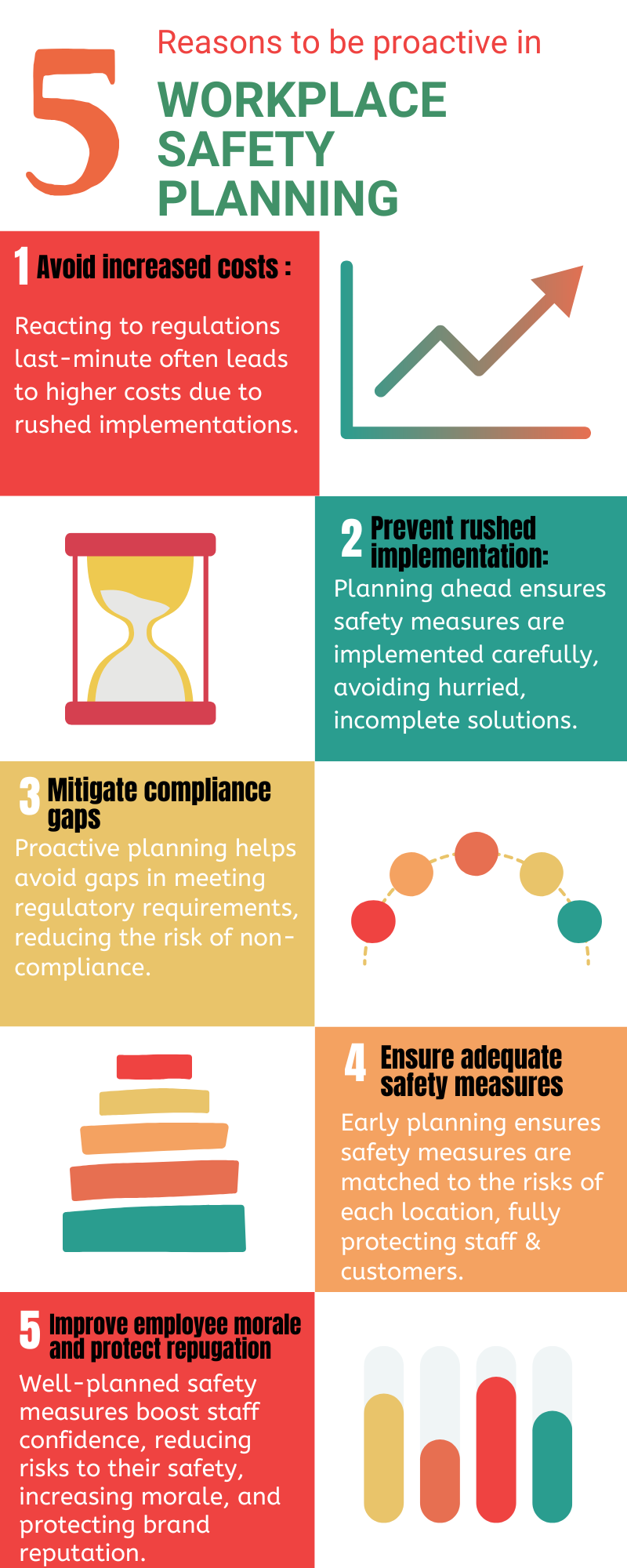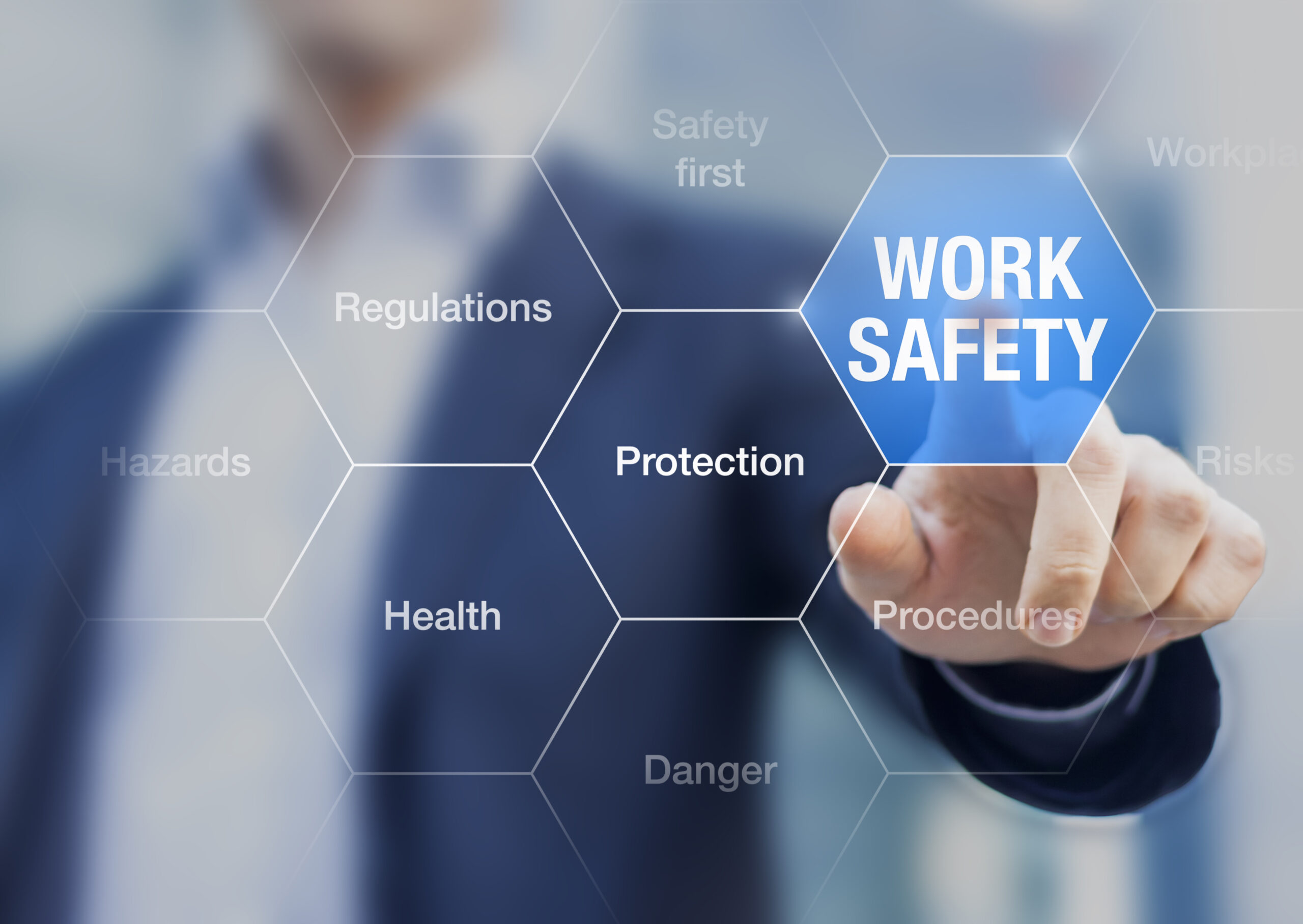Stay Ahead of Workplace Safety Legislation
Using Proactive Risk Assessments to Build Effective Workplace Safety Plans
As workplace violence continues to rise, the need for proactive safety measures is more apparent than ever. States like California, New York, and Virginia are leading the way with legislation encouraging or requiring business to create a workplace safety plan to protect employees…and it’s likely that more states will follow their lead. To stay ahead of regulatory changes, businesses must take a proactive approach, beginning with a thorough understanding of the specific risks at each of their locations. Including crime risk assessments in your suite of evaluation tools will provide essential insights that inform the development of effective violence prevention programs and help prepare for emerging workplace safety standards.

Why Proactive Measures Are Key
Waiting to react to regulations often leaves businesses scrambling to meet deadlines, which can lead to increased costs, rushed implementations, and potential compliance gaps. This reactive approach may result in inadequate safety measures that do not fully address the specific risks present at each location, putting employees and customers at greater risk. Additionally, organizations may face reputational damage if incidents occur due to insufficient planning, leading to increased danger for staff, decreased employee morale and diminished trust from stakeholders. A proactive approach allows organizations to anticipate changes and take meaningful steps to address risks before they escalate into major issues. Assessing crime risk early on gives businesses the necessary insight to tailor their workplace safety plans to each location’s unique needs while developing comprehensive programs that align with legislative requirements.
Making a Holistic Approach to Risk Assessment
Assessing workplace risks goes beyond just understanding past crime incidents—it’s about considering a wide range of factors, including local demographics, socio-economic conditions, and environmental variables, to create a more accurate and comprehensive risk profile.
Most businesses, however, lack the resources or expertise to collect and analyze such comprehensive data on their own. Using third-party, industry-proven crime risk models can provide advanced tools and insights that help businesses prioritize locations and align their practices with workplace safety legislation.
Place Matters: The Importance of Location in Assessing Risk
Every business location presents its own unique set of risks. These risks are shaped not only by past crime but also by a range of local factors: crime patterns, socio-economic conditions (like poverty, unemployment, level of education, and family structure), and environmental influences (like neighborhood density, presence of commercial establishments, and environmental disturbances like weather events and high temperatures). To create a comprehensive workplace safety plan, it’s crucial to understand that each location will have different needs and vulnerabilities. This is where a quality crime risk report becomes essential—it doesn’t just focus on past incidents but also considers multiple variables that can contribute to future risk, providing a full, data-driven picture.
By using this broader view, businesses can design safety strategies that are tailored to the specific risk profile of each location. For example, an elevated-risk urban area may require more robust security measures, such as surveillance systems and employee training for handling violent situations. In contrast, a low-risk suburban office might focus on preventing workplace harassment or practicing de-escalation techniques. Customizing your workplace violence prevention plan in this way not only ensures compliance with emerging safety regulations but also helps create safer, more secure environments for employees and customers alike.
A Phased Approach: Addressing Locations Based on Risk
Understanding the correlation between elevated crime risk in an area and an increase in workplace violence is crucial for effective workplace safety plans. Research shows that workplace violence is often driven by broader community dynamics rather than being unique to the workplace itself.1 The movement of individuals in and out of the workplace can bring societal violence with them, increasing the risk for employees. By prioritizing high-risk locations, businesses can address these underlying factors, acknowledging that workplace safety is intrinsically linked to the safety of the surrounding community. This proactive focus not only helps in reducing immediate threats but also lays the groundwork for a safer work environment that considers the larger context of societal violence.
Once high-risk locations are secured, businesses can turn their attention to lower-risk areas in a second wave. This phased approach allows companies to efficiently manage resources while ensuring that all locations meet safety requirements. In lower-risk areas, the focus may shift to harassment prevention, employee training, and ensuring that violence prevention protocols are in place, albeit with less urgency.

Talk with a Compliance Expert
Supporting Safety Protocols with Crime Risk Reports
Crime risk assessments, such as those provided by CAP Index, offer critical insights that empower businesses to evaluate specific risks tied to each location. CAP Index’s assessments go beyond reviewing past crime incidents; they incorporate a wide range of factors, including local demographics, socio-economic conditions, and environmental variables. This multi-layered approach provides a more nuanced view of risk, helping organizations design tailored safety measures that align with emerging regulations.
CAP Index’s CRIMECAST® platform further enhances decision-making by integrating data into interactive mapping layers. These layers allow businesses to visualize the risk profile across multiple locations, whether within CAP Index’s own platform or integrated into an existing GIS system. By accessing a dynamic view of location-specific risks, businesses gain actionable insights that support phased rollouts of safety measures, prioritizing high-risk areas while ensuring that all sites benefit from informed, data-driven strategies.
Conclusion
As states push forward with workplace safety legislation, incorporating location-based risk assessments, like CAP Index’s, into your safety strategy is the first step toward creating effective violence prevention programs that protect employees and meet legal requirements. CAP Index’s tools allow for a phased approach, focusing resources on high-risk locations initially and adjusting protocols based on site-specific risk factors. This proactive model not only optimizes resources but also builds trust among employees, customers, and stakeholders, supporting a safer work environment tailored to the unique needs of each location.
Legislative Breakdown: Overview of Bills Enacted and/or in Progress
Mandates the development of workplace violence prevention programs and hazard assessments, focusing on public-facing employees. Employers are required to maintain an incident log, with certain sectors like healthcare and law enforcement currently exempt.
This bill focuses on the retail industry, requiring employers to provide workplace violence prevention programs and panic buttons for employee protection.
Requires companies with over 100 employees to develop workplace violence policies and maintain records of violent incidents for at least five years.
 Sample CRIMECAST Reports
Sample CRIMECAST Reports